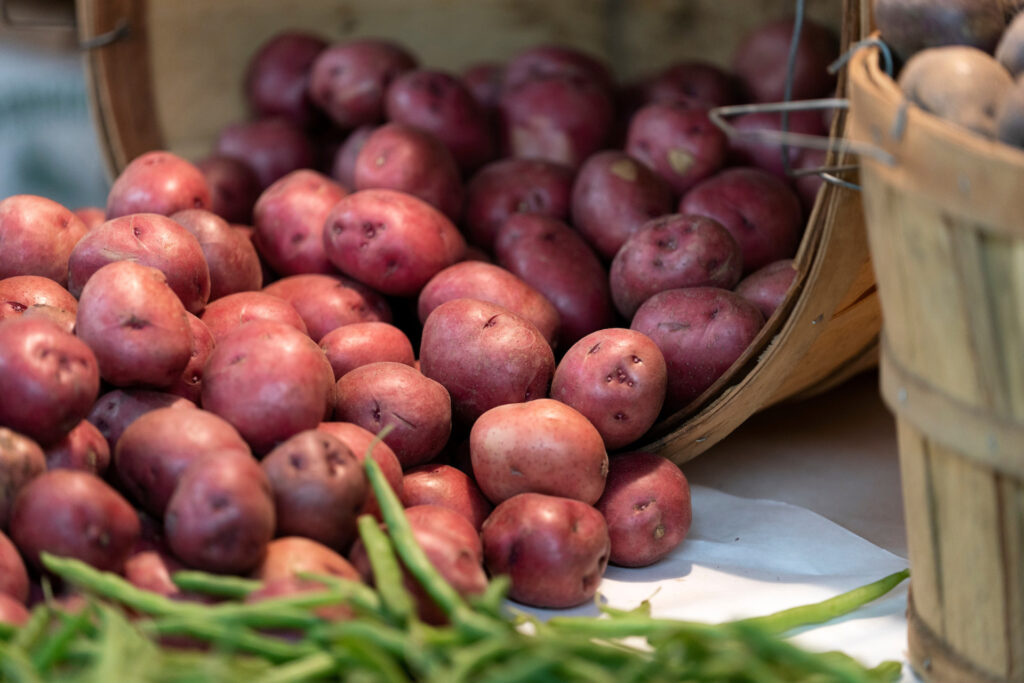VIEWpoly provides visual map for polyploid plant geneticists, breeders
Texas A&M Department of Horticultural Sciences leads search for cutting-edge genetic tools for flowering plants
Cristiane Taniguti, Ph.D., is doing her part to revolutionize the field of genetic analysis of polyploid plants with her software tool, VIEWpoly.

These plants are everywhere in daily life. Polyploids have more than two identical or similar chromosome sets. They include horticultural crops like roses, many turf and forage grasses as well as a range of food crops from bananas, kiwis and blackberries to potatoes and sweet potatoes to arabica coffee. Polyploid plants have an annual value of more than $9 billion in the U.S. and many times that value globally, according to the U.S. Department of Agriculture National Institute of Food and Agriculture, NIFA.
Taniguti is a postdoctoral research associate in a research group led by Oscar Riera-Lizarazu, Ph.D., associate professor and Texas A&M AgriLife Research plant geneticist in the Texas A&M College of Agriculture and Life Sciences Department of Horticultural Sciences. She has a background in developing models and software for genetic analysis, and most recently created VIEWpoly as a new user-friendly tool that is changing how plant geneticists and breeders identify and visualize genetic traits.
Riera-Lizarazu said VIEWpoly is a significant addition to the computational tool kit for the genetic analysis of polyploid crops available to researchers and plant breeders.
“VIEWpoly provides a user-friendly interface to view, explore and mine results from multiple genetic analysis tools and is having a tremendous impact on the way we study and analyze plant species genomes and how we design strategies for breeding improved cultivars,” he said.
An expanding role for genetic analysis software in horticulture
Taniguti’s master and doctoral work at the University of São Paulo in Brazil focused on developing software for genetic analysis. She worked on projects like OneMap, a software for building linkage maps, and tools to analyze quantitative trait loci, a region of DNA associated with a particular phenotypic trait.
But she always was interested in working with polyploid crops, such as sugarcane, which posed additional challenges because of their complex genetic makeup. VIEWpoly brings together results and output from multiple polyploid genome sequencing tools and helps users visualize the genetic data.
VIEWpoly expands on other genetic analysis tools created through a USDA-NIFA Specialty Crop Research Initiative grant project that includes national and international collaborators in academia from Arkansas, Maine, New York, North Carolina, Oregon, Pennsylvania, Texas, Washington and Wisconsin as well as the Netherlands and New Zealand.
“I looked forward to working with polyploids and expanding the model to include them because it’s hard. It’s complex,” she said. “And I think this type of visualization tool shows plant breeders what these genetic tools are capable of doing.”
VIEWpoly provides visual map for polyploid genetic architecture
VIEWpoly offers three main browsing options to users: QTL browsing, genome browsing and map browsing. These options cater to different user requirements, allowing them to analyze quantitative traits, explore genetic relationships and examine linkage maps.
Taniguti is also working on incorporating multi-population analysis for polyploids, which will enhance VIEWpoly’s capabilities further.
VIEWpoly is an important step in the evolution of genetic analysis tools for plants, said David Byrne, Ph.D., AgriLife Research rose breeder and professor and geneticist in the Department of Horticultural Sciences.
Riera-Lizarazu and Byrne received $4.3 million in 2020 from the Specialty Crop Research Initiative for a four-year grant-funded project to develop tools for genomics-assisted breeding in polyploids.
Despite the importance of polyploid crops, major obstacles to using genomic tools in the past included a lack of suitable software and technical expertise. Prior to polyploid tool development, researchers only used genomic information for diploid crops such as corn, rice, soybeans and tomatoes.
Riera-Lizarazu said Taniguti’s background in agriculture and genetics and her abilities as a biocomputational scientist allow her to bridge these fields.
“Dr. Taniguti is the whole package,” he said. “She can communicate effectively with plant breeders and geneticists as seamlessly as with programmers. That makes her invaluable when it comes to the continued development but also the delivery and outreach aspects of the technology.”



VIEWpoly enhances genetic tools, technology
Byrne said these new computational tools and technology enable the use of genomic information to accelerate the rate of genetic gain in a wide range of polyploid breeding programs. This will lead to a more rapid development of higher quality, more productive and more resilient cultivars.
These software tools map genes in polyploids by locating phenotypic traits of interest and linking those traits to the associated DNA. The software works with a range of polyploid crops: tetraploids such as roses, potatoes and blackberries; hexaploids such as sweet potatoes; and octoploids such as strawberries and more.
The software also works well with diploids, and researchers are modifying it to deal with odd ploidy levels such as triploids, which include bananas, hops and seedless watermelons.
VIEWpoly enhances the application of these tools. Byrne said excitement about genetic tools continues to grow within the plant breeding field, and VIEWpoly is making them more user-friendly.
“A lot of cutting-edge work has gone into the computational side of improving the polyploid tools, and VIEWpoly is helping us better analyze, visualize and map where genes reside,” he said. “It allows us to look at where a gene is and see the connections we need to make. That visual context is incredibly valuable.”
VIEWpoly continues to evolve through collaboration
VIEWpoly was born out of Taniguti’s desire to bridge the gap between developers and end-users.
Taniguti was excited about the opportunity to collaborate with breeders and the community to develop software that would be both useful and accessible. The idea was to create a tool that people without programming skills could utilize.
She understood the importance of creating software that was not just technically impressive but also practical for breeders. By engaging with breeders and understanding their needs, Taniguti ensures that VIEWpoly provided useful features and avoided unnecessary complexities.
Taniguti said VIEWpoly evolved through collaboration with other developers and input from geneticists and breeders. She regularly communicates with fellow developers to incorporate new features and functionalities based on user feedback and user requirements.
Collaboration is easier through platforms like GitHub, where developers can share and edit code, regardless of their location. This collaborative approach ensures that VIEWpoly continues to evolve and adapt to meet the needs of breeders and researchers worldwide.
“The idea is putting together all these tools that are being used in the project,” she said. “I have many collaborators who deserve the spotlight, and I want to thank them and all the people who give us feedback about this tool. We want to continue the work and receive more feedback that will improve genetic tools and ultimately plants.”


